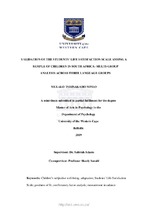| dc.description.abstract | While research into children’s subjective well-being (SWB) has advanced over the
past decade, there is a paucity of cross-cultural research, particularly in South Africa.
Moreover, while the adaptation and validation of instruments in English and Afrikaans are
evident, other language groups have not received much attention. This study aimed to provide
structural validation of the Students’ Life Satisfaction Scale across a sample of children in
South Africa using multi-group analysis across three language groups (Setswana, Xitsonga,
and Tshivenda). Within this process, the study aimed to use multi-group confirmatory factor
analysis (MGCFA) to compare the structural validity and measurement invariance of the three
language groups. Finally, the study aimed to determine the convergent validity of the three
language groups of the SLSS by regressing them onto the single-item Overall Life
Satisfaction Scale (OLS). The study uses data from Wave 3 of the South African Children’s
Worlds Study and included a sample of 625 children across the language groups (Setswana: n
= 187; Sesotho: n = 170; and Tshivenda: n = 268). For the overall pooled sample an excellent
fit was obtained for a single-factor model, including one error-covariance. Standardised
regression weights of the items ranged between .43 and .73. MGCFA revealed an acceptable
fit for the configural model (unconstrained loadings); however, metric (constrained loadings)
and scalar invariance (constrained loadings and intercepts) was not tenable. However, through
the application of partial constraints metric invariance was tenable when Item 5 (I like my
life) was freely estimated, while scalar invariance was tenable when Item 1 (I enjoy my life)
and Item 5 (I like my life) were freely estimated. The results suggest that the Items: My life is
going well; I have a good life; The things in my life are excellent; and I am happy with my
life, are comparable by correlations, regression coefficients, and latent mean scores across the
three language groups. Convergent validity using the OLS was obtained for the pooled sample
and across the language groups. The key contribution of the study is establishing that the
Setswana, Sesotho, and Tshivenda translated and adapted versions of the SLSS are valid for
use within the South African context to measure children’s SWB, and that they can be
grouped together in an overall pooled sample. | en_US |

